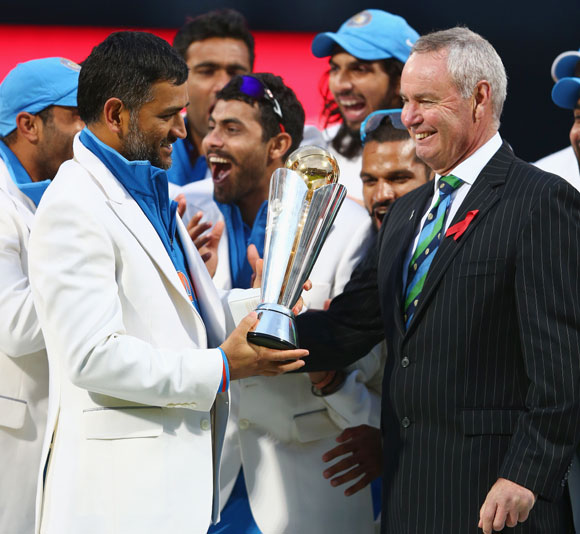 | « Back to article | Print this article |
Cricket lovers, meet the New India!
The Indian formula, says Faisal Shariff, exemplifies that the action bias in sport yields fewer results much like the goalkeeper who dives to the left or right during a penalty kick even when one-third of all balls land in the middle of the goal.
India suffered two successive whitewashes in England and Australia. There were calls for a very public review to ascertain the factors that contributed towards the twin disasters. It was akin to what England and Australia did after suffering similar defeats.
The opaque systems of Indian cricket certainly deserve kudos sometimes and this was one such occasion.
If we were in the 1980s or 1990s, India would surely have had three captaincy changes and two coaches sacked. But this is the new India!
The BCCI, as is their wont, chose to be quiet and conducted a quiet review behind the scenes and chose to make changes required in what now looks like a calibrated and precise manner.
Indian systems or procedures can frustrate at the best of times and this was no different. But there was a periodic and systemic change in what was happening with the side in all three formats, the benefits of which we are slowly reaping benefits.
Australia, on the other hand, went full steam ahead with the changes suggested by the Don Argus panel. From independent board to an all-powerful head coach, a captain doubling up as selector. All the changes were made in full public view.
What happened next? The head coach was sacked, the captain is no longer selector and the only thing that remains is an independent board.
India, on the other hand, made quiet changes to the way the team is operated.
The Test team first: Senior pros like Rahul Dravid quit while ahead. V V S Laxman got the message and jumped before being pushed.
Later in 2012, Virender Sehwag was shown the door, then Gautam Gambhir, Zaheer Khan and Yuvraj Singh made their exits, but after losing to England for the first time at home since 1984-1985.
The exits of all the senior pros from the Test squad gave India the benefits much later in the season when a young resurgent team beat Australia 4-0.
Harbhajan Singh was the next casualty even in celebrations of the well-earned decimation of Australia.
The ODI team faced the next churn. Mahendra Singh Dhoni attempted the unthinkable, rested seniors like Sehwag, Gambhir, Zaheer and Sachin Tendulkar at periodical times during a tri-series in Australia last year.
The target was to get the side ready for the World Cup in 2015 to be played in the same country, even at the cost of short-term losses. There was a backlash and he backtracked.
In the larger scheme of things it was a speeding ticket for the Indian skipper.
Cricket lovers, meet the New India!
Sachin Tendulkar himself bowed out gracefully later in the year, realising that he wouldn’t be around for the World Cup in 2015. Sehwag and Gambhir were still picked for the ODI series against Pakistan.
The result: the side lost to Pakistan 2-1 and the outrage started all over again.
The selectors and Dhoni bit the bullet, dropped Sehwag first, then Zaheer which gave India a chance to keep its hold over England in ODIs at home.
But that was not it, come the Champions Trophy and the selectors were bolder than ever. Yuvraj, till then a regular in the ODI squad, was shown the door.
There was no longer any place for Sehwag, Gambhir, Zaheer and Harbhajan in the ODI scheme of things. The young squad went ahead and stamped their authority to show why the defending world champion is also the number-one ranked ODI team.
The Indian approach at turning things around may be a bit old fashioned, but as they say success papers over many cracks.
India’s bold new set of selectors led by the Sandy Storm of his times, Sandeep Patil, has been brave. In the face of fans and the media asking for rash actions, the selectors have stuck to their sensible wait-and-see strategy.
It is almost as if long-term gains are looked at even at the cost of short-term losses.
Australia, on the other hand, has looked at short-term gains at the cost of long-term losses. And that shows mostly in the way the squad was chosen for the Ashes and the Champions Trophy.
For all the blame and flak the BCCI takes, what has been forgotten is that there has been some effort to get the junior/development squads touring around the world.
Last year, the India A squad was in West Indies and New Zealand. This year, the India A team will be in South Africa, followed by home series against West Indies A and New Zealand A.
Next year just before India tours England, an India A side will tour the UK. So the younger players will get a chance to acclimatize themselves to the conditions. Apart from that, an India development squad visits Australia every year.
We have not seen any such proactive approach from Australia apart from this year when its A side has been in Ireland, England and Zimbabwe.
The benefits of that may be reaped by Australia in coming years, but they have to be patient and from all accounts quiet in their approach to set things right.
The Indian formula exemplifies that the action bias in sport yields fewer results much like the goalkeeper who dives to the left or right during a penalty kick even when one-third of all balls land in the middle of the goal.
India’s Twenty20 side needs much work to be done, but that is for a different day and time!

